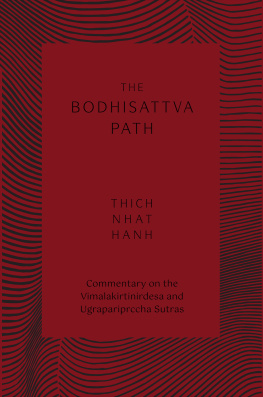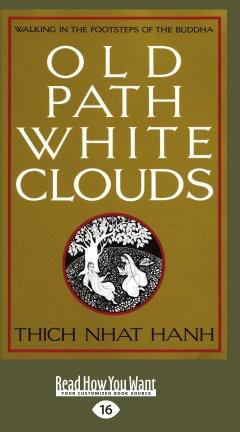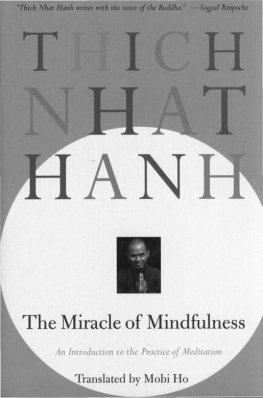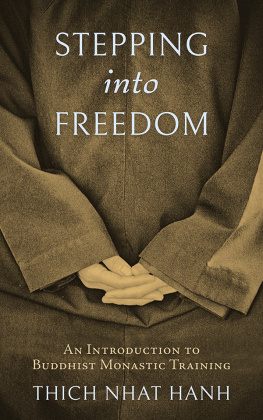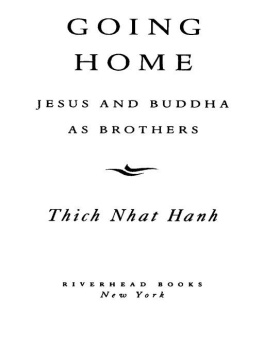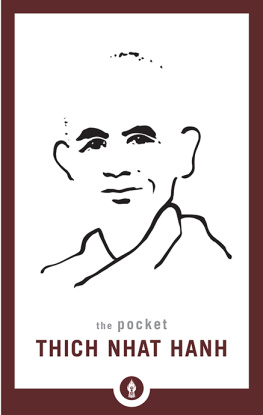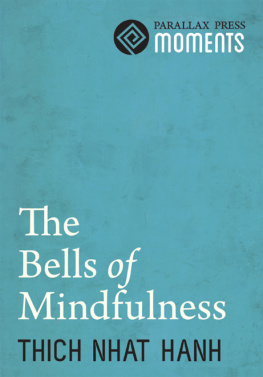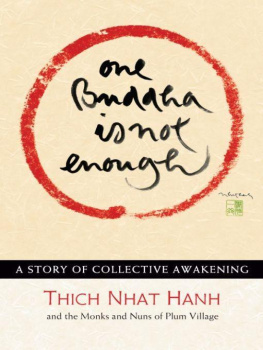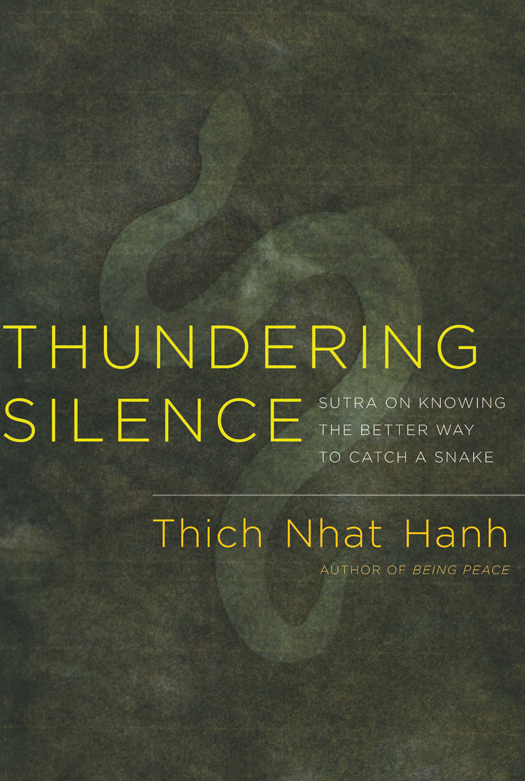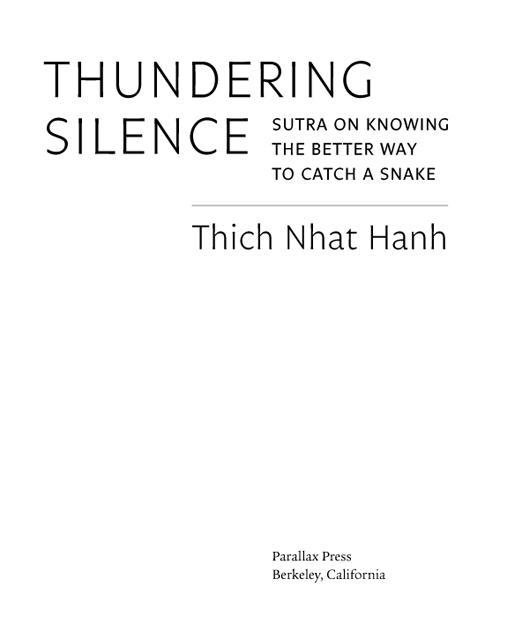Parallax Press
P.O. Box 7355
Berkeley, California 94707
Parallax Press is the publishing division of Unified Buddhist Church, Inc.
1993, 2009 by Unified Buddhist Church.
All rights reserved.
Translated from the Vietnamese by Annabel Laity.
Cover design by Jess Morphew.
Trade Paperback text design by Scribe Typography.
LIBRARY OF CONGRESS CATALOGING-IN-PUBLICATION DATA
Nht Hanh, Thch.
Thundering silence: sutra on knowing the better way to catch a snake/Thch Nht Hanh. 2nd ed.
p. cm.
Translated from the Vietnamese by Annabel Laity.
ISBN 978-1-888375-98-5
Ebook ISBN 978-1-935209-01-0
1. Tipitaka. Suttapitaka. Majjhimanikaya. Alagaddupama Sutta Commentaries. I. Laity, Annabel. II. Tipitaka. Suttapitaka. Majjhimanikaya. Alagaddupama Sutta. English. III. Title.
BQ1320.A4222E543 2009
294.3823 dc22
2009002644
v3.1
Contents
Introduction
IN THE SUTRA ON KNOWING THE BETTER WAY TO CATCH a Snake, the Buddha urges us to study and practice his teachings in an intelligent way so we will not be caught by notions and words. The sutra reminds us that if we are skillful and careful in learning and practicing the Buddhas teachings, then we can experience peace and joy right in this present moment. For those of us new to Buddhism and practice, it is a wonderful beginning. For experienced practitioners, the sutra can bring space and fresh air back into our practice. The Buddha encourages us to be like a person who can catch a snake without being bitten by it. Before reading this sutra, Id never before heard anyone compare his or her teaching to a snake or say that it can be dangerous to learn and practice.
There are two different versions of this sutra, the Pali version from the Tamrashatiya school and the Chinese version from the Sarvastivada school. By comparing the two, we can discover something close to the original words of the Buddha. It is wonderful to receive these teachings.
Although his teachings are deep, the Buddha likes to present them in a simple way. While describing the interdependent-origination nature of reality, for example, he simply says, This is, because that is. This may not sound difficult, but it is very profound and easy to misunderstand. The Buddha taught the Sutra on Knowing the Better Way to Catch a Snake because many people, including many monks and nuns in the Buddhas own time, misinterpreted or misrepresented his teachings. One example of this is the teaching of the Three Dharma Seals of impermanence, no-self, and nirvana. These three insights are wonderful keys for unlocking the door to reality, but they continue to be misunderstood from generation to generation.
Many people think that the Buddha believed in nonbeing, annihilation, the destruction of all feelings and intentions, and the dissolution of identities. This isnt so. The Buddha taught that we must go beyond pairs of opposites such as being and nonbeing, becoming and annihilation. This sutra is full of openness, playfulness, and nonattachment from views. In reminding us to use great care and skill while studying and practicing his teachings, the Buddha uses another wonderful parable. He reminds us that if we use a raft to cross a river, we need to give up the raft when weve made it to the other shore. Instead of continuing to carry it with us, we leave it on the shore for others to use.
In the Mahayana tradition there is a saying of the Buddha: During forty-five years, I have not said anything. This statement is truly the roar of a great lion. In the Vimalakirti Nirdesha Sutra (Taisho 475), the silence of the layman Vimalakirti is praised by the Bodhisattva Manjushri as a thundering silence that echoes far and wide, having the power to break the bonds of attachment and bring about liberation. It is the same as the lions roar that proclaims, It is necessary to let go of all the true teachings, not to mention teachings that are not true. This is the spirit we need if we want to understand the Buddhas teachings. For this reason, we have given this book the title, Thundering Silence. May the Sutra on Knowing the Better Way to Catch a Snake sweep away the fog of words and notions in us so that the sun of the true teaching can shine brightly on the field of our understanding mind.
Sutra on Knowing the Better Way to Catch a Snake
Sutra on Knowing the Better Way to Catch a Snake
I HEARD THESE WORDS ONE TIME WHEN THE BUDDHA was staying at the Anathapindika Monastery in the Jeta Park, near Shravasti. At that time, the Bhikshu Arittha, who before being ordained had been a vulture trainer, had the wrong view that according to the teachings of the Buddha, sense pleasures are not an obstacle to the practice. After hearing this, many bhikshus went to Arittha and asked, Brother Arittha, do you really believe that the Buddha teaches that sense pleasures are not an obstacle to the practice?
Arittha replied, Yes, friends, it is true that I believe the Buddha does not regard sense pleasures as an obstacle to the practice.
The bhikshus scolded him, Brother Arittha, you misrepresent the Buddhas teachings and even slander him. The Lord has never said that sense pleasures are not an obstacle to the practice. In fact, he uses many examples to teach that sense pleasures are an obstacle to the practice. You should abandon your wrong view. Although the bhikshus counseled Arittha in this way, he was not moved to change his view. Three times they asked him to abandon his wrong view, and three times he refused, continuing to say that he was right and the others were wrong.
So the bhikshus went to the hut of the Buddha, prostrated at the Lords feet, sat to one side, and addressed him respectfully, World-Honored One, the Bhikshu Arittha says that according to the teachings of the Lord, sense pleasures are not an obstacle to the practice. We asked him three times to abandon his wrong view, but he continues to hold to this view. So we have come to you, Lord. What should we do?
Hearing this, the Buddha asked one of the bhikshus to invite Arittha to come to his hut. The bhikshu stood up, prostrated himself, circumambulated the Buddha three times, and went to Bhikshu Arittha. When Arittha heard that the Lord wanted to see him, he came right away, prostrated before the Buddha, and sat to one side. The Buddha said, Arittha, is it true you have been saying that I teach that sense pleasures are not an obstacle to the practice?
Arittha replied, Yes, LordI do believe that according to the spirit of your teachings, sense pleasures are not an obstacle to the practice.
The Lord admonished him. Arittha, what could have led you to that view? When did you ever hear me teach that sense pleasures are not an obstacle to the practice? Who has said that I teach that? Arittha, you are not correct. Your brothers in the Dharma have advised you to drop your wrong view, and you should. The Buddha then asked the other monks, Bhikshus, have you ever heard me teach that sense pleasures are not an obstacle to the practice?
The bhikshus replied, No, Lord, we have not.
The Buddha then asked, What have you heard me teach?
The bhikshus replied, We have heard the Lord teach that sense pleasures are an obstacle to the practice. Lord, you have said The Lord said, Bhikshus, that is correct. I have always taught that sense pleasures are an obstacle to the practice. Sense pleasures are like a skeleton, a piece of raw meat, a straw torch, a pit of burning charcoal, a poisonous snake, a dream, borrowed belongings, or a tree laden with fruit. Bhikshu Arittha, you have misunderstood both the letter and the spirit of my teachings. You have presented my teachings as the opposite of what I intended. You have misrepresented and even slandered me, and, at the same time, you have done harm to yourself and others. This is a serious transgression that will cause noble teachers and sincere practitioners much sadness. Hearing the Lords reprimand, Bhikshu Arittha bowed his head in silence. He was hurt and upset and could think of nothing at all to say.


